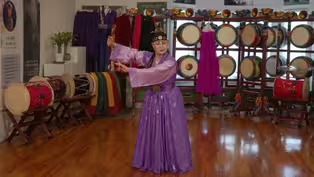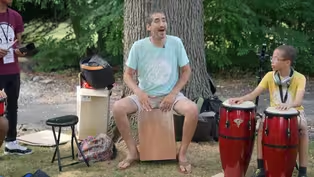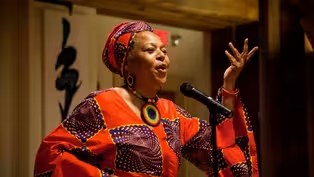State of the Arts
Bomba y Plena: Juan Cartagena & Nanette Hernández
Clip: Season 43 Episode 3 | 6m 29sVideo has Closed Captions
Juan Cartagena and Nanette Hernández blend social justice with Puerto Rican Bomba y Plena.
Percussionist Juan Cartagena and dancer Nanette Hernández combine their passion for social justice with the practice of Puerto Rican Bomba y Plena. They founded Segunda Quimbamba in Jersey City where they preserve and celebrate their Puerto Rican heritage by performing and teaching traditional Puerto Rican music and dance throughout New Jersey and the Tri-State region to people of all ages.
Problems playing video? | Closed Captioning Feedback
Problems playing video? | Closed Captioning Feedback
State of the Arts is a local public television program presented by NJ PBS
State of the Arts
Bomba y Plena: Juan Cartagena & Nanette Hernández
Clip: Season 43 Episode 3 | 6m 29sVideo has Closed Captions
Percussionist Juan Cartagena and dancer Nanette Hernández combine their passion for social justice with the practice of Puerto Rican Bomba y Plena. They founded Segunda Quimbamba in Jersey City where they preserve and celebrate their Puerto Rican heritage by performing and teaching traditional Puerto Rican music and dance throughout New Jersey and the Tri-State region to people of all ages.
Problems playing video? | Closed Captioning Feedback
How to Watch State of the Arts
State of the Arts is available to stream on pbs.org and the free PBS App, available on iPhone, Apple TV, Android TV, Android smartphones, Amazon Fire TV, Amazon Fire Tablet, Roku, Samsung Smart TV, and Vizio.
Providing Support for PBS.org
Learn Moreabout PBS online sponsorship♪♪ Shortly after getting married, four decades ago, Juan and Nanette started looking for ways to preserve and celebrate their Puerto Rican heritage.
♪♪ -We both really were looking for ways to connect to traditions that our own parents did and different parts, because I was born and raised here in Jersey, and she was born and raised in Pennsylvania.
But we both have the same Christmastime traditions of music, live music, that comes around Christmastime, and a tradition called Parrandas, which means basically caroling with live music, house to house to house.
-For me, Juan Cartagena is a very important mentor and elder to me.
I think he's a wonderful example of a beautiful, healthy masculinity within Puerto Rican culture and within any culture.
-There's so much beauty in how much family and community that they bring and how welcome they make everybody feel.
-Bomba from Puerto Rico goes back at least 450 years.
It is played on large barrel drums, but it reflects the incredible history of the middle and western parts of Africa, particularly areas that were now Congo of Africa.
A lot of the languages and words that we still use in our Bomba music today are also derived from Congo languages of of that region of Africa.
♪♪ -We are an ensemble based in Jersey city, and for me personally, this has been honestly my family's work.
My parents are the founders of the organization, and so I have been part of the group since I -- before I could remember, honestly.
The group plays Bomba and Plena in Jersey City and throughout the Tri-State Area.
We've also toured in Spain, Barbados, and Puerto Rico, as well.
-[Narrator] Every spring, all of Segunda Quimbamba's students and their families come together for a grand performance.
♪♪ ♪♪ -[Rosa] And my mother, Nanette Hernández, she's our master dancer within the group, and she has been really the leader of our education program.
♪♪ -There are thousands of children in New Jersey that have benefited from the incredible work of Nanette.
♪♪ What makes Bomba super unique is that the dancer is a major element of the music.
-The movements can be from your upper body or your lower body.
It can be footwork.
And then there are certain patterns that you learn to dance in certain counts and certain moves.
When I go -- dot dot boom, dot dot boom.
-I'm trying to anticipate her dance movements, but because she knows I'm trying to anticipate it, and because we've danced and chanted together for so long, she may not give me a four beat count.
She'll just stop at two and I'm over here, we're getting ready to strike at the third and the fourth, and if I did it, I blew it.
And if I blow it, she gives me this look like, "What are you doing?"
And it's, look, it's a conversation now, now it's a conversation between, you know.
♪♪ [ Applause ] -My father has really instilled in both my brother and I, and I think also in our community, a real sense of purpose and identity, both culturally in this music and continuing to practice these forms, but also politically.
-When we started doing Plena and Bomba, for me, it was a logical extension of the work that I do professionally, which is that I'm a civil rights attorney, and I've represented both Latino-Latina communities in the United States for decades and decades and decades, along with African American communities.
And those kind of elements about how to ensure that inclusion is actually respected and that everyone's contributions to our -- this beautiful country that we live in, are respected and valued, goes hand in hand with the kind of work that we're doing in Quimbamba.
-As we were younger, you know, I think we would have Father's Days where his idea of celebrating Father's Day was going to a protest, and that's where we would be, you know.
He'd say, "I know it's raining, but it's Father's Day, and that's where I'd like to be."
♪♪ -Plena's portable.
All the percussion instruments are hand-held and Plena is also anchored in the lyricism of its words.
It's played at every baseball game in Puerto Rico, and Puerto Rico loves its baseball.
Then it's played in every protest, every labor strike.
We play Plena at wakes -- -[Nanette] And graduations.
-And graduations.
And baptisms.
It's the gamut.
♪♪ [ Cheers and applause ] -This year, Juan and myself have been recognized with Segunda Quimbamba as honorees of the National Puerto Rican Day Parade in New York City.
♪♪ It's very exciting.
It's very affirming.
♪♪ We do this music, we preserve this culture, not solely for the joy that it brings and the immense musical talent that we can kind of cultivate within our family and with our community as a whole, but also because it is very much a part of our resistance as people who are descended from colonial subjects that are still colonized to this day.
♪♪ [ Cheers and applause ]
Korean Dance & Drums: Lena Mija Kim
Video has Closed Captions
Clip: S43 Ep3 | 5m 32s | Lena Mija Kim, a master of Korean dance, passes the art form down to the next generation. (5m 32s)
Peruvian Cajon Player: Hector Morales
Video has Closed Captions
Clip: S43 Ep3 | 5m 24s | Hector Morales brings traditional Afro-Peruvian music to the U.S. from Lima, Peru. (5m 24s)
Video has Closed Captions
Clip: S43 Ep3 | 6m 36s | Queen Nur shares her ancestral history and preserves African culture through storytelling. (6m 36s)
Providing Support for PBS.org
Learn Moreabout PBS online sponsorshipSupport for PBS provided by:
State of the Arts is a local public television program presented by NJ PBS


















